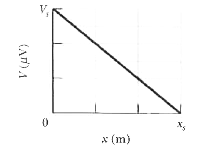Problems from RESNICK AND HALLIDAY PHYSICS Chapter 6 CURRENT AND RESISTANCE for Class 12
| Class 12 | PHYSICS |
| Chapter | CURRENT AND RESISTANCE |
| RESNICK AND HALLIDAY PHYSICS | Problems |
| Medium | English |
| Academic Year | 2023-2024 |
Question 2
In Fig. 26-18a, a 9.00 V battery is connected to a resistive strip that consists of three sections with the same cross-sectional areas but different conductivities. Figure 26-18h gives the electric potential V(x) versus position x along the strip. The horizontal scale is set by x= 8.00 mm. Section 3 has conductivity 4.00×107(Ω.m)−1. What is the conductivity of section (a) 1 and (b) 2 ?
a. View Solution
View SolutionQuestion 3
In Fig. 26.19, current is set up through a truncated right circular cone of resistivity 731Ω.m lelt radius d= 1.70 mm. right radius b= 2.30 mm, and length L= 3.50 cm. Assume that the current density is uniform across any cross section taken perpendicular to the length. What is the resistance of the conc? View Solution
View SolutionQuestion 4
Kiting during a storm. The legend that Benjamin Franklin flew a kite as a storm approached is only a legend-he was neither stupid nor suicidal. Suppose a kite string of radius 2.00 mm extends directly upward by 1.80 km and is coated with a 0.500 mm layer of water having resistivity 150Ω.m. If the potential difference between the two ends of the string is 213 MV, what is the current through the water layer? The danger is not this current but the chance that the string draws a lightning strike, which can have a current as large as 500 000 A (way beyond just being lethal).View SolutionQuestion 5
Earth's lower atmosphere contains negative and positive ions that are produced by radioactive elements in the soil and cosmic rays from space. In a certain region, the atmospheric electric field strength is 120 V/m and the field is directed vertically down. This field causes singly charged positive ions, at a density of 640cm−1 to drift downward and singly charged negative ions, at a density of 550 cm−3. ? to drift upward (Fig. 26-20). The measured conductivity of the air in that region is 2.70×10−14W(Ω.m)−1. Calculate (a) the magnitude of the current densily and (b) the ion drift speed, assumed to be the same for positive and negative ions.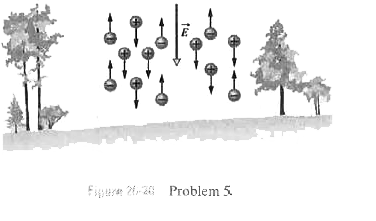 View Solution
View SolutionQuestion 7
Figure 26-21 shows wire section 1 of diameter D1=4.00R and wire section 2 of diameter D2=1.75R, connected by a tapered section. The wire is Copper and carries a current. Assume that the current is uniformly distributed across any cross-sectional area through the wire's width. The electric potential change V along the length L= 2.00 m shown in section 2 is 10.0μV. The number of charge carners per unit volume is 8.49×1028m−3. What is the drift speed of the conduction electrons in section 1?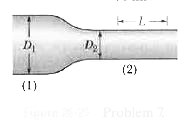 View Solution
View SolutionQuestion 9
In Fig. 26-22a, a 15Ω resister is connected to a battery. Figure 26-22b shows the increase of thermal energy Eth in the resistor as a function of time t. The vertical scale is set by Eth.s=2.50mJ, and the herizontal scale is set by ts=4.0s. What is the electric potential across the battery?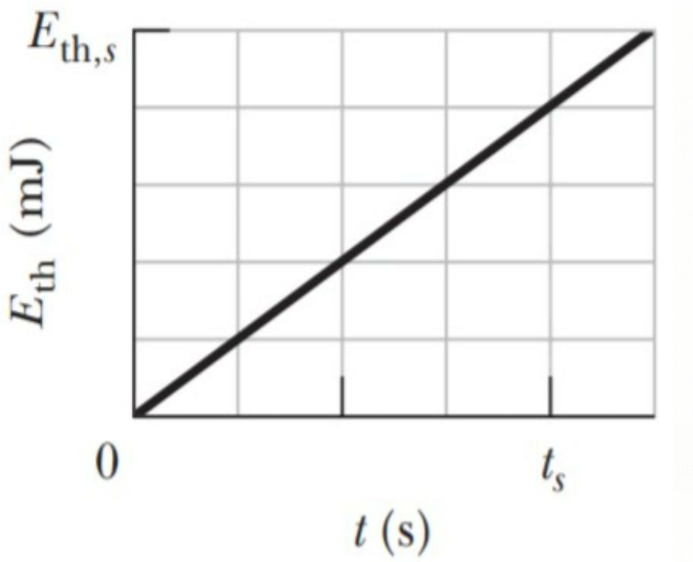 View Solution
View SolutionQuestion 10
Nichrome wire consists of a nickel-chromium-iron alloy, is commonly used in heating elements such as on a stove, and has conductivity 2.0×106(Ω.m)−1. If a Nichrome wire with a cross-sectional area of 2.3 mm2? carries a current of 5.5 A when a 1.4 V potential difference is applied between its ends, what is the wire's length?View SolutionQuestion 11
A heater contains a Nichrome wire (resistivity 5.0×10−7Ω.m) of length 5.85 m, with an end-to-end potential difference of 112 V and with a dissipation power of 4000 W.(a) What is the wire's cross-sectional area? (b) If 100 V is used to obtain the same dissipation rate, what should the length be?View SolutionQuestion 13
In Fig. 26.23, a battery of potential differenc V= 12 V is connected to a resistive strip of resistance R=4.0Ω. When an electron moves through the strip from one end to the other, (a) in which direction in the figure does the electron move, (b) how much work is done on the electron by the electric field in the strip, and (c) how much energy is transferred to the thermal energy of the strip by the electron?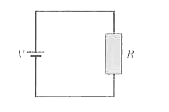 View Solution
View SolutionQuestion 16
Wire C and wire D are made from different materials and have length LC=LD=1.0m. The resistivity and radius of wire C are 2.0×10−6.Ωm and 1.00 mm, and those of wire D are 1.0×1.0−6Ω.m. and 0.50 mm. The wires are joined as shown in Fig. 26-25, and a current of 2.0 A is set up in them. What is the electric potential difference between a) points 1 and 2 and (b) points 2 and 3? What is the rate at which energy is dissipated between c) points 1 and 2 and (d) points 2 and 3?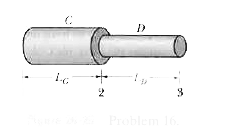 View Solution
View SolutionQuestion 18
The current through the battery and resistors 1 and 2 in Fig. 26-26a is 1.50 A. Energy is transferred from the current to thermal energy Eth in both resistors. Curves 1 and 2 in Fig. 26-26b give that thermal energy Ein for resistors 1 and 2, respectively, as a function of time i. The vertical scale is set by Eth.s=40.0mJ and the horizotal scale is set by ts=5.00s. What is the power of the battery?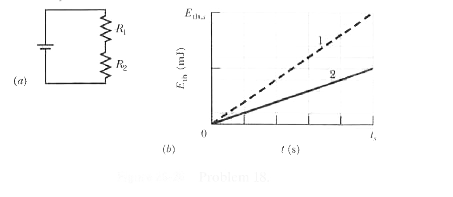 View Solution
View SolutionQuestion 22
A charged belt, 50 cm wide, travels at 30 m/s between a source of charge (electrons) and a sphere. The belt carries charge into the sphere at a rate corresponding to 76 A. (a) Compute the surface charge density on the belt. (b) What is the number density (number per unit area) of the electrons on the belt?View SolutionQuestion 27
Figure 26-27 a shows a rod of resistive material. The resistance per unit length of the rod increases in the positive direction of the x axis. At any position x along the rod, the resistance dR of a narrow (differential) section of width dx is given by dR =5.00x dx, where dR is in ohms and x is in meters. Figure 26-27 shows such a narrow section. You are to slice off a length of the rod between x= 0 and some position x= L and then connect that length to a battery with potential difference V=8.0 V (Fig. 26-27c). You want the current in the length to transfer energy to thermal energy at the rate of 180 W. At what position x =L should you cut the rod?
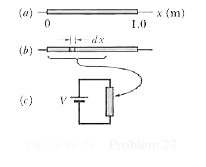 View Solution
View SolutionQuestion 28
A fuse in an electric circuit is a wire that is designed to melt, and thereby open the circuit, if the current exceeds a predetermined value. Suppose that the material to be used in fise melts whien the current derisity rises to 440 Acm2. What radius of cylindrical wire should be used to make a haal will little current to 6.0A?View SolutionQuestion 31
A certain cylindrical wire carries current. We draw a circle of radius r around its central axis in Fig. 26-28a to determine the current i within the circle. Figure 26-28b shows current i as a function of r2. The vertical scale is set by is=4.0mA, and the horizontal scale is set by r2s=8.0mm2. (a) Is the current density uniform? (b) If so, what is its magnitude? (c) What is the current between r = 0 and r=2.0 mm?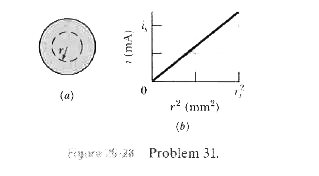 View Solution
View SolutionQuestion 32
Figure 26-29a gives the magnitude E(x) of the electric fields that have been set up by a battery along a resistive rod of length 9.00 mm (Fig. 26-296). The vertical scale is set by Es=8.00×103V/m. The rod consists of three sections of the same material but with different radii. (The schematic diagram of Fig. 26.29b does not indicate the differencet radii). The radius of section 3 is 1.70 mm. What is the radius of (a) section 1 and (b) section 2?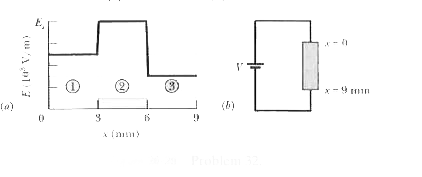 View Solution
View SolutionQuestion 34
Near Earth the density of protons in the solar wind (a stream of particles from the Sun) can be 4.63cm−3 and their suced can be 391 km/s. (a) Find the current density of these protons. (b) If Earth's magnetic field did not deflect the protons, what total current would Earth receive?View SolutionQuestion 36
The magnitude of the current density in a certain lab wire with a circular cross section of radius R=2.50 mm is given by J=(3.00×108)r2, with J in amperes per square meter and radial distance rin meters. What is the current through the outer section bounded by r= 0.900R and r=R?View Solution
